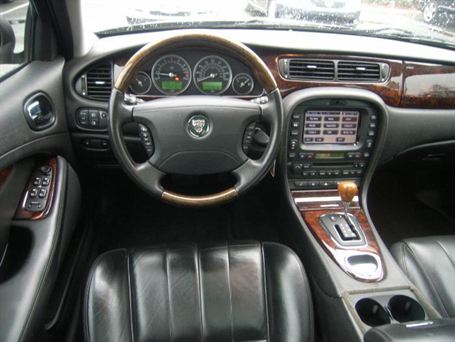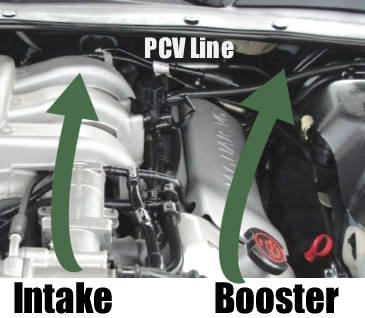Jaguar PCV Valve Vacuum Leak & Lean Codes
February 26, 2012 10:13 am How To Auto Repair, Lean Codes© DenLorsTools.com Summary: Lean codes P0171 and P0174 are some of the most common codes there are for Ford and Jaguars. If the car runs lean enough there can also be a misfire code. Here’s a recent question from one of our readers. See the original article linked towards the bottom of this page.
The question – Hi DennisB, First I have to say thanks to all the comments on here I feel more prepared to tackle my issue, or should I say the repair shop. So, I would REALLY appreciate your advice because after doing some research, it may very well be that I have a faulty elbow, leaky hose, or dirty filter. I would like to try the inexpensive repairs FIRST, instead of the other way around, especially since the shop suggested the items listed below. Okay, here it goes, I have a 2000 Jaguar S-Type V6 and just a little over a week my check engine light came on. Since then, I noticed my car starting to idle oddly while in Park or foot on the brake at a stop. It runs fine at all speeds, but, recently over the week it stalled 3 separate times while I in park only. It turns right back on with no problem, but of course I want to fix the problem. I have been doing research and I just found this awesome blog and learned that maybe it is a simple repair (crossing fingers and toes) since my car has been hissing when the car is cold and in cold weather only. Well, I took it in to the shop earlier today and they said that P0171, P0174, and P0300 registered ( I previously learned what these were when I researched my cars symptoms) and they said that they were trying to isolate which one of the engine sensors was the cause/problem. After a while they came back and asked me if my car had stalled, when, and how often. I told them that only a few times and only while in park. 30 minutes later they recommended the following under each category. Please note that I didn’t tell them about the hissing because I just learned about the potential of it being a Large Vacuum Leak So, I would like your advice as to how I should proceed before I give up an arm, a leg and a half!
GASKETS-ENGINE
Intake Manifold Gaskets(Both Upper & Lower) *Parts and Labor $591.04
ENGINE SENSORS
Remove and Replace PCV Valve
*Parts and Labor $278.29
TOTAL with Taxes $893.42
Needles to say I almost passed out, I say almost because I know its a Jag that typically comes with higher repair costs. Oh yeah, and they told me that I should not drive my car too much because it is misfiring
I THANK YOU in advance!
My Answer – If I were checking the car I would try to pinpoint the vacuum leak. I remember working on a few Jaguar S Types that had a common issue with the PCV vacuum line assembly leaking vacuum. See the image for the approximate location to look. Running more roughly with the brake on at idle goes along consistently with a vacuum leak since the power brake booster draws more vacuum from the engine to provide assisted/power brake action. When the car is at higher RPM’s this is much less noticeable. *Note; A bad/leaking power brake booster could cause the issue too, but is a much less common failure.
The PCV (Positive Crankcase Ventilation) valve is not really a sensor like in the estimate you were provided. If the valve is available by itself and not just as an “assembly” with the hose or molded line altogether, they are rather inexpensive. However, I suspect that the PCV for your car is only sold as the more expensive assembly (probably a dealer only part). While it is possible; the PCV valve “itself” is probably not the problem, most likely it’s the line cracked and leaking somewhere. On some Jaguars, the intake must be removed to access and replace the PCV line assembly. That is most likely why the repair shop has given you an estimate for the intake seals as well. If intake seals are re-used there’s a chance they would leak ruining the job. So the only professional way to price the job out is to replace, and not take a chance of the intake seals.
Things you can do.
1. Check for an obvious vacuum leak in the area I pointed out in the picture. If you find a vacuum line try repairing just the section that is leaking. If a plastic line leaks, cut it and use a rubber hose that snugly makes the union. If a rubber vacuum hose leaks, use a plastic line in the same manner.
2. If you end up paying the shop to do the repair, make sure you are not paying for duplicate labor. If you are paying for the intake R&R to access the PCV line assembly, you should not have to pay full price (or full boat) for the PCV line labor as well. This is known as double dipping! It’s OK to pay some labor for the PCV line, you just shouldn’t have to pay double. Good Luck.
Linking: Please reference this car repair article when quoting, linking to this page is welcomed and appreciated. If you are new to linking a page. 1. Left click the link; to highlight 2. Right click, select copy 3. Right click the link and paste to car forums, auto repair blogs, car repair web sites etc. Thanks! Disclaimer: Automobile repair tips are designed for informational purposes only, without warranty of any kind, in no event shall the author of this site be liable for any consequential, incidental or direct damages sustained in the course of using the repair information in this article. All rights reserved by DenLors Auto (Automotive specialty tools /Car mechanics Tools). Keep us in mind for auto tool needs, shop supplies and car mechanics equipment.
Related Auto Repair Articles


RaynsMommy :
Date: February 27, 2012 @ 9:30 pm
Thank you for your prompt response and the picture!
You are right about the PCV part because the mechanic told me that he would have to get it from the dealer. Also, now I understand why they quoted the job including the Intake Manifold Gaskets. Okay, so this morning I actually checked for the “hissing/whisting” and it seems to be coming from the direction of either the PCV or the intake- I can’t exactly pinpoint it but it is inbetween those 2 areas. I was poking around and it’s most likely a coincidence, but when I touched a rubber L shaped part behind the intake the car seemed to change in idle. But, how do I check for a leak without hurting myself? LOL and if and when I find a leak can you also kindly walk me through the steps you mention under the “Things you can do #1” I have no clue how to cut the plastic line, what type of rubber hose to use. Same for the the rubber leak… I really need a step by step in laymans terms. I am sure you are super busy, but know that this single mommy will be very grateful and will PAY IT FORWARD!
dennisb - Auto Tool Sales :
Date: February 28, 2012 @ 6:48 am
If moving the hoses around does affect the idle it may not be a coincidence. It’s important to know also that, sometime the elbow can be collapsed restricting vacuum, not just simply leaking. To check for a leak, I would use propane to check for the leak in that area. The hose and valve assembly below is used when attached to a regular propane bottle. Click the image to see the detailed description.

A shop would most likely fill the crankcase with leak detection smoke and look for smoke to come of the hose that leaks (or elsewhere like from the intake seals). There are a lot of moving parts and items that may be hot to the touch – so if you are not comfortable under the hood, I recommend having someone help that is. It’s not worth getting hurt to save a few bucks.
Although there are many ways, one way plastic or rubber can be cut safely is with a simple pair of diagonal side cutters. Click on the image to see the tool for sale.

If you find a line or hose leaking, I recommend going to your local parts store for assistance in purchasing the right size and type of hose or line. Most parts stores have knowledgeable guys that will be more than willing to assist you. Good Luck